Intel Core i7 3960X (Sandy Bridge E) Review: Keeping the High End Alive
by Anand Lal Shimpi on November 14, 2011 3:01 AM EST- Posted in
- CPUs
- Intel
- Core i7
- Sandy Bridge
- Sandy Bridge E
No Integrated Graphics, No Quick Sync
All of this growth in die area comes at the expense of one of Sandy Bridge's greatest assets: its integrated graphics core. SNB-E features no on-die GPU, and as a result it does not feature Quick Sync either. Remember that Quick Sync leverages the GPU's shader array to accelerate some of the transcode pipe, without its presence on SNB-E there's no Quick Sync.
Given the target market for SNB-E's die donor (Xeon servers), further increasing the die area by including an on-die GPU doesn't seem to make sense. Unfortunately desktop users suffer as you lose a very efficient way to transcode videos. Intel argues that you do have more cores to chew through frames with, but the fact remains that Quick Sync frees up your cores to do other things while SNB-E requires that they're all tied up in (quickly) transcoding video. If you don't run any Quick Sync enabled transcoding applications, you won't miss the feature on SNB-E. If you do however, this will be a tradeoff you'll have to come to terms with.
Tons of PCIe and Memory Bandwidth
Occupying the die area where the GPU would normally be is SNB-E's new memory controller. While its predecessor featured a fairly standard dual-channel DDR3 memory controller, SNB-E features four 64-bit DDR3 memory channels. With a single DDR3 DIMM per channel Intel officially supports speeds of up to DDR3-1600, with two DIMMs per channel the max official speed drops to 1333MHz.
With a quad-channel memory controller you'll have to install DIMMs four at a time to take full advantage of the bandwidth. In response, memory vendors are selling 4 and 8 DIMM kits specifically for SNB-E systems. Most high-end X79 motherboards feature 8 DIMM slots (2 per channel). Just as with previous architectures, installing fewer DIMMs is possible, it simply reduces the peak available memory bandwidth.
Intel increased bandwidth on the other side of the chip as well. A single SNB-E CPU features 40 PCIe lanes that are compliant with rev 3.0 of the PCI Express Base Specification (aka PCIe 3.0). With no PCIe 3.0 GPUs available (yet) to test and validate the interface, Intel lists PCIe 3.0 support in the chip's datasheet but is publicly guaranteeing PCIe 2.0 speeds. Intel does add that some PCIe devices may be able to operate at Gen 3 speeds, but we'll have to wait and see once those devices hit the market.
The PCIe lanes off the CPU are quite configurable as you can see from the diagram above. Users running dual-GPU setups can enjoy the fact that both GPUs will have a full x16 interface to SNB-E (vs x8 in SNB). If you're looking for this to deliver a tangible performance increase, you'll be disappointed:
| Multi GPU Scaling - Radeon HD 5870 CF | |||||
| Max Quality, 4X AA/16X AF | Metro 2033 (19x12) | Crysis: Warhead (19x12) | Crysis: Warhead (25x16) | ||
| Intel Core i7 3960X (2 x16) | 1.87x | 1.80x | 1.90x | ||
| Intel Core i7 2600K (2 x8) | 1.94x | 1.80x | 1.88x | ||
Modern GPUs don't lose much performance in games, even at high quality settings, when going from a x16 to a x8 slot.
I tested PCIe performance with an OCZ Z-Drive R4 PCIe SSD to ensure nothing was lost in the move to the new architecture. Compared to X58, I saw no real deltas in transfers to/from the Z-Drive R4:
| PCI Express Performance - OCZ Z-Drive R4, Large Block Sequential Speed - ATTO | ||||
| Intel X58 | Intel X79 | |||
| Read | 2.62 GB/s | 2.66 GB/s | ||
| Write | 2.49 GB/s | 2.50 GB/s | ||
The Letdown: No SAS, No Native USB 3.0
Intel's current RST (Rapid Story Technology) drivers don't support X79, however Intel's RSTe (for enterprise) 3.0 will support the platform once available. We got our hands on an engineering build of the software, which identifies the X79's SATA controller as an Intel C600:
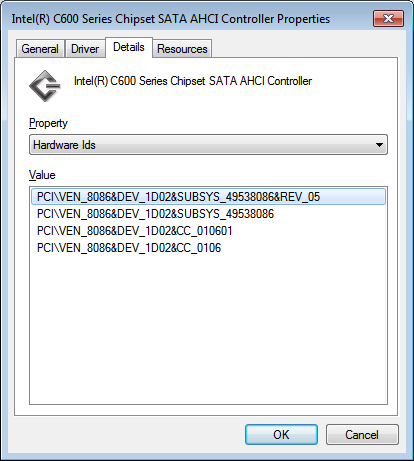
Intel's enterprise chipsets use the Cxxx nomenclature, so this label makes sense. A quick look at Intel's RSTe readme tells us a little more about Intel's C600 controller:
SCU Controllers:
- Intel(R) C600 series chipset SAS RAID (SATA mode)
Controller
- Intel C600 series chipset SAS RAID ControllerSATA RAID Controllers:
- Intel(R) C600 series chipset SATA RAID ControllerSATA AHCI Controllers:
- Intel(R) C600 series chipset SATA AHCI Controller
As was originally rumored, X79 was supposed to support both SATA and SAS. Issues with the implementation of the latter forced Intel to kill SAS support and go with the same 4+2 3Gbps/6Gbps SATA implementation 6-series chipset users get. I would've at least liked to have had more 6Gbps SATA ports. It's quite disappointing to see Intel's flagship chipset lacking feature parity with AMD's year-old 8-series chipsets.
I ran a sanity test on Intel's X79 against some of our H67 data for SATA performance with a Crucial m4 SSD. It looks like 6Gbps SATA performance is identical to the mainstream Sandy Bridge platform:
| 6Gbps SATA Performance - Crucial m4 256GB (FW0009) | ||||||
| 4KB Random Write (8GB LBA, QD32) | 4KB Random Read (100% LBA, QD3) | 128KB Sequential Write | 128KB Sequential Read | |||
| Intel X79 | 231.4 MB/s | 57.6 MB/s | 273.3 MB/s | 381.7 MB/s | ||
| Intel Z68 | 234.0 MB/s | 59.0 MB/s | 269.7 MB/s | 372.1 MB/s | ||
Intel still hasn't delivered an integrated USB 3.0 controller in X79. Motherboard manufacturers will continue to use 3rd party solutions to enable USB 3.0 support.


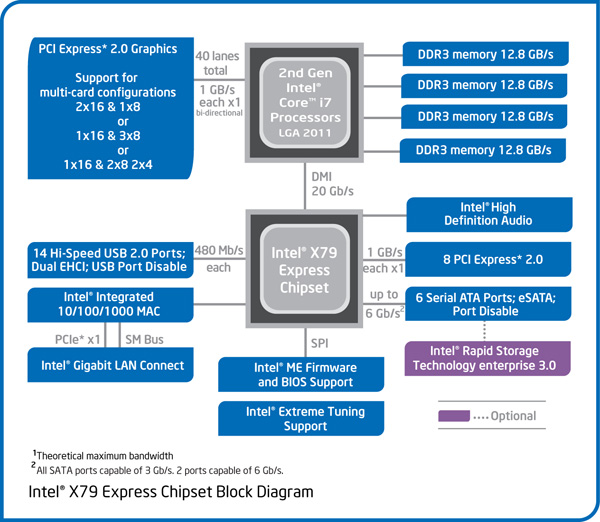
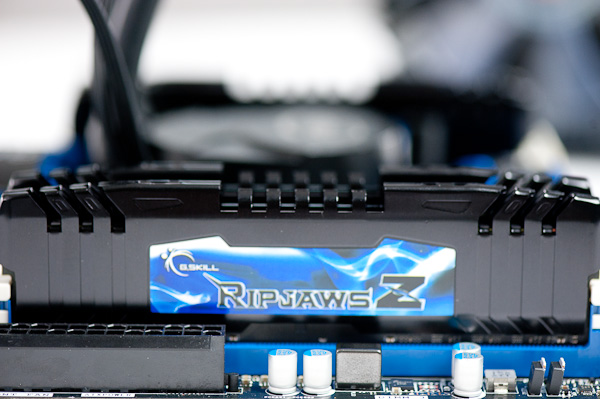
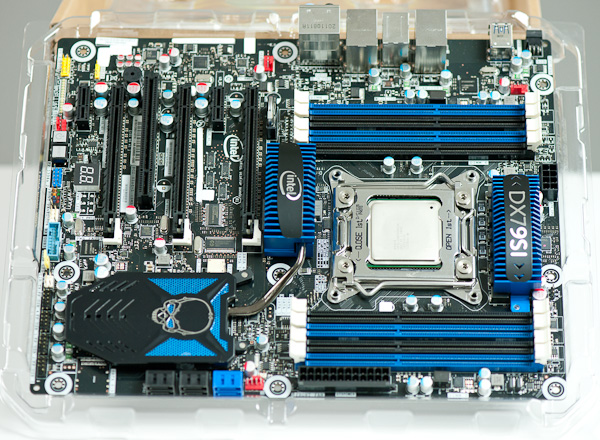
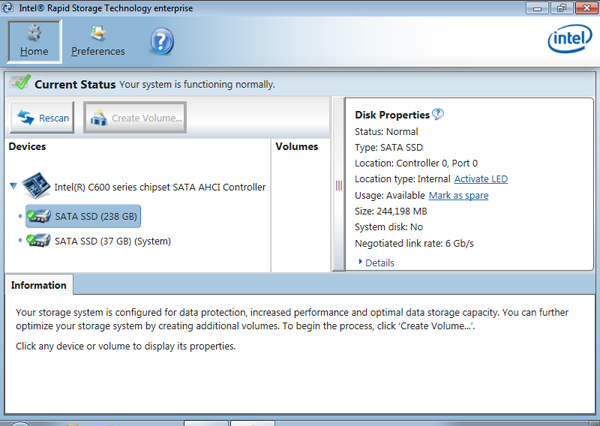








163 Comments
View All Comments
jabber - Monday, November 14, 2011 - link
...with Pixar updating their rendering farm?I cant think of many other big customers for this kind of chip.
randinspace - Monday, November 14, 2011 - link
Wouldn't they be using Xeons?gevorg - Monday, November 14, 2011 - link
Could the wasted space for 2 fused cores and their L3 cache been used for HD2000 graphics? Wish Intel would have avoided wasting die space like this.GL1zdA - Monday, November 14, 2011 - link
It's not wasting, it's binning. They could either throw away 8-cores with damaged cores or sell them as six-cores, which is what they did.BSMonitor - Monday, November 14, 2011 - link
Actually it's not binning in this case. (some chips from the Xeon line might be) But these "desktop" CPUs are actually the 8-core Xeon line trimmed down in both cost and validation for use in Desktop PCs. Intel's currently roadmap is 6-core desktop CPU's at the high-end with extremely high memory bandwidth.It is cheaper for them to fuse two cores from an 8-core Xeon production line, than to redesign another CPU die for just the high-end 6-core desktop line. This class is by no means high-volume, hence yet another CPU die would be expensive.
GL1zdA - Monday, November 14, 2011 - link
Could you test how Sandy Bridge-E behaves in vt_benchmark when GPU trancoding is used? I'm curious, if SBE will do better than a nVidia 580. And what is the difference between 2600K+580 and 3960X+580 when GPU transcoding is enabled.Kevin G - Monday, November 14, 2011 - link
Intel crippled both the CPU and the chipset with this launch. I was hoping to see an 8 core model at the high end. The chip design itself is an 8 core die so why not a fully functional chip for the low volume extreme edition? The performance benefits of the Core i7 3960X over the 990X mirror those from the 2600K over the 875K. (Well actually the 2600K vs. 875K comparison is much wider due to the clock speed differences, not just the architectural changes.) Sure it is faster at stock but generally not worth upgrading to, especially factoring in motherboard cost. Another let down is that the chip doesn't officially support PCI-E 3.0 True that their are no PCI-E 3.0 cards on the market today but there will be tomorrow. Not sure if this is additional crippling to distinguish the consumer chips from the coming LGA2011 Xeons or if there actually was a problem running at PCI-E 3.0 speeds.Speaking of Xeons, this article didn't mention if the system has the two QPI links disabled. If not, there could be the remote chance of a manufacturer releasing a board with the X79 using DMI and an X58 chipset hanging off of a QPI link. That would allow for another two full bandwidth PCI-E 16X slots at 2.0 speeds without the usage of a bridge chip.
Then there is the X79 chipset. The reality is that it offers very little over the Z68. No USB 3.0 or additional SATA ports are the big things. Knowing Intel, we'll likely see a Z79 chipset that'll enable the SAS functionality for those that want more storage. Hopefully the hypothetical Z79 chipset will also use some of the PCI-E lanes from the CPU for additional bandwidth as an array of SSD's would easily be able to saturate the current DMI link.
I'm also curious if these X79 consumer boards will allow for some overclocking with an LGA 2011 Xeon. I'm not expected full multiplier controller but rather feeding that 125 Mhz or 166 Mhz base clock to the CPU would suffice. Getting one of these consumer boards and paying the Xeon premium may wind up being the way to go for a true leap over of the Core i7 990X.
khanov - Monday, November 14, 2011 - link
This is a good question, I guess many would wonder why this is the case. To understand why requires a little insight into the manufacturing of silicon chips:
As with almost any manufacturing process there are variables that differentiate one product coming off the same assembly line from the next. So for example at a car factory each 'identical' engine is in fact a little different from another, whether it be the balancing of the crankshaft or the exact fit of the bearings.
With the manufacturing of CPUs (and indeed any silicon chips) there are also small differences between the chips that come off the same assembly line. If a chip has a defect for example (which happens too frequently) the defective area of the chip needs to be disabled. In essence this is why we are seeing Sandy Bridge-E cpus launching with disabled cores.
The fully enabled cores (eight cores and 20MB L3 cache) are being sold as (or will soon be sold as) Xeon chips for the highest price. Somewhat lesser cores with defects are being sold as lower end Xeons with six cores or as consumer Sandy Bridge-E chips with six cores. Even more defective chips that can only work with four cores enabled are being stockpiled and will soon be sold as four core Sandy-Bridge-E and Xeon chips.
So basically all these chips are manufactured with eight 'possible' cores. There is no wasted space on the die. However due to imperfect manufacturing processes some of these chips will have defects. In fact the larger the die area the more likely a defect occurs within each chip. With a very large die area for SB-E intel is now experiencing a problem more often seen by GPU manufacturers such as Nvidia. They are dealing with the problem in the same way: While Nvidia sell a GTX580 with die defects as a GXT570, intel sells a defective 8 core SB-E as a fully working 6 core Xeon or SB-E chip.
Once we see an improvement of the manufacturing process (which is an ongoing process of improvement) we will start to see lower cost SB-E chips and also possibly fully enabled, defect-free SB-E for desktop/workstation users.
javalino - Monday, November 14, 2011 - link
AGREE!!!!I will wait for a native 6 core, it will be much cooler , and maybe 1% fasterkarakarga - Monday, November 14, 2011 - link
Hi,From i386 DX-40 times, AMD build it's worst CPU ever. With 2 Billion transistors, instead of 0,9 Billion transistors. Typically new Bulldozer architecture have not much effect. So they doubled the transistor count for nothing! A very poor design. I am thinking AMD FX-8150 is not an eight core but considering new AMD bullozer 8C CPU as a 4 core but 8 threaded. Intel here reached 2,3 Billion transistors. But the performance is about 1,5 times better than AMD.
Chipset details are known. The lack of having only two SATA-600 ports is a disadvantage. Lack of native USB 3.0 support prevents mainboards fully passing to the new speed standard.
But AMD is also not good at chipset design too. I am currently using 990FX chipset with 1090T cpu. The memory performance is not reaching to 10GB/s with four DDR3-2133 rams working at 1600MHz default. If I put this CPU on a 790FX mainboard with only two piece DDR2-1066 rams, it passes 13GB/s. Which means the old serie upto 1100T are designed for DDR2 and not poolished and optimized fine for DDR3 memory. Only advantage here is having 6 SATA-600 ports, thats all!